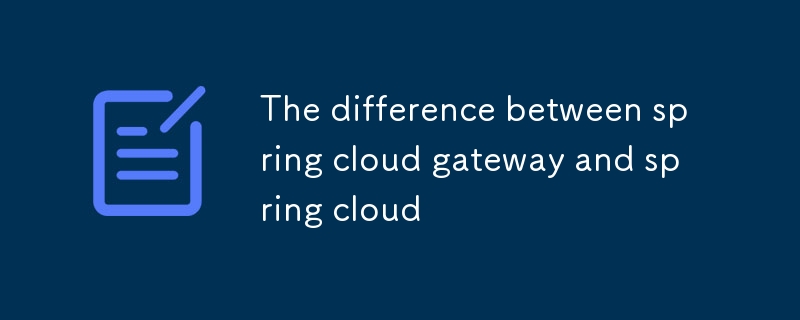Home >Common Problem >The difference between spring cloud gateway and spring cloud
The difference between spring cloud gateway and spring cloud
- DDDOriginal
- 2024-08-15 15:49:211453browse
Spring Cloud Gateway, a lightweight gateway for microservices, differs from Spring Cloud, a comprehensive framework with a wider service scope. Gateway's focus on simplified routing and security suits scenarios requiring focused functionality, while

What are the key differences between Spring Cloud Gateway and Spring Cloud?
Spring Cloud Gateway and Spring Cloud are both frameworks for building microservices-based applications. However, there are some key differences between the two frameworks:
- Architecture: Spring Cloud Gateway is a lightweight gateway that is designed to sit in front of your microservices and handle routing, security, and other common tasks. Spring Cloud, on the other hand, is a more comprehensive framework that provides a wide range of services, including service discovery, configuration management, and circuit breaking.
- Functionality: Spring Cloud Gateway is focused on providing a gateway to your microservices. It can be used to handle tasks such as routing, security, and rate limiting. Spring Cloud, on the other hand, provides a broader range of services, including service discovery, configuration management, and circuit breaking.
- Ease of use: Spring Cloud Gateway is a lightweight and easy-to-use framework. It can be easily deployed in front of your microservices and configured with a few lines of code. Spring Cloud, on the other hand, is a more complex framework that requires more configuration and setup.
How does Spring Cloud Gateway compare to Spring Cloud in terms of functionality and architecture?
As mentioned above, Spring Cloud Gateway is a lightweight gateway that is designed to sit in front of your microservices and handle routing, security, and other common tasks. Spring Cloud, on the other hand, is a more comprehensive framework that provides a wide range of services, including service discovery, configuration management, and circuit breaking.
In terms of functionality, Spring Cloud Gateway provides a limited set of features compared to Spring Cloud. However, Spring Cloud Gateway is specifically designed for use as a gateway, and it is very good at what it does. Spring Cloud, on the other hand, is a more general-purpose framework that can be used for a wider range of tasks.
In terms of architecture, Spring Cloud Gateway is a very lightweight framework. It can be easily deployed in front of your microservices and configured with a few lines of code. Spring Cloud, on the other hand, is a more complex framework that requires more configuration and setup.
In what scenarios is Spring Cloud Gateway a better choice than Spring Cloud?
Spring Cloud Gateway is a better choice than Spring Cloud in scenarios where you need a lightweight gateway that is easy to deploy and configure. Spring Cloud Gateway is also a good choice if you are only interested in using a subset of the features that Spring Cloud provides.
Spring Cloud is a better choice than Spring Cloud Gateway in scenarios where you need a more comprehensive framework that provides a wider range of services. Spring Cloud is also a better choice if you are looking for a framework that is more flexible and customizable.
The above is the detailed content of The difference between spring cloud gateway and spring cloud. For more information, please follow other related articles on the PHP Chinese website!

